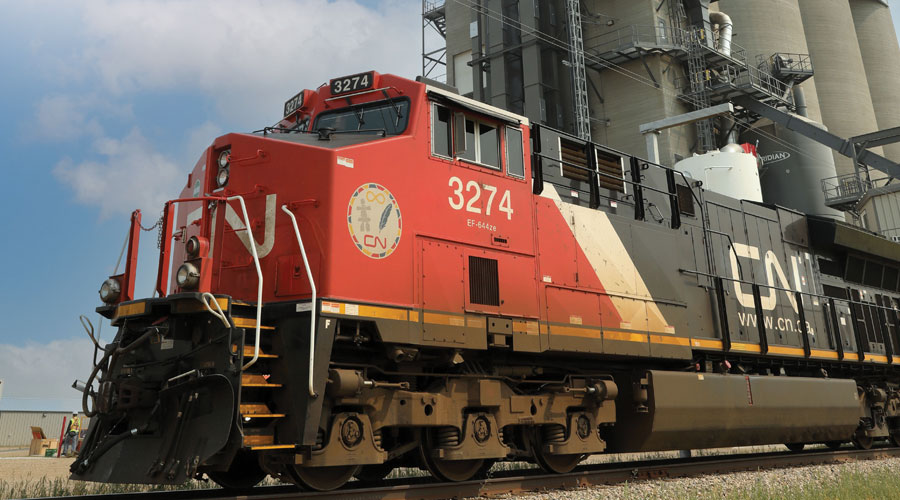Stay updated on news, articles and information for the rail industry
September 2014
Rail News: Canadian National Railway - CN
At CN, Serge Leduc is taking an integrated approach to managing the information technology department
— by Pat Foran, editor
After a decade of crisscrossing the Atlantic while leading the information technology charge for a global tobacco company, Serge Leduc last year had a decision to make: put down stakes in the United Kingdom or return home to Canada and chart a new career course in rail. He chose the latter. "Our two young kids were more Brits than French Canadians," says Leduc, who joined CN in April 2013 as senior director of IT and was named vice president and chief information officer in December 2013. "But after a long discussion with my family, we decided to come back to Montreal."
There were other factors. It certainly helped that in North America, freight rail is a growth industry. Then there was the organization that is CN: The Class I's "precision railroading" model and focus on supply chain collaboration resonated with Leduc, who during the previous 25 years held various senior positions for Canadian and U.K. organizations with experience in sales, supply chain, manufacturing and retail.
"At CN, the business is growing," Leduc says. "And there are so many exciting opportunities for IT to support that business, to support that growth and to support the operating model of the railroad."
Leduc began his IT career in the mid-1980s as a consultant, mostly serving what he terms "big firms in Montreal." In 1991, Leduc took the first big turn on his career path, joining the newsprint and specialty papers division of Montreal's Domtar Inc., where he served as director of information systems management. There, he planned and developed an overhaul of the management information systems supporting the division's sales and manufacturing processes. Leduc held the post until 1994, when he was named VP of IT for Alliance Forest Products Inc., another Montreal-based company. He spent the next seven years there, managing the IT function at a growing company with operations in Canada and the United States.
In 2002, Leduc switched industry gears, joining London-based British American Tobacco plc's (BAT) Imperial Tobacco Canada as senior manager of IT operations. His boss was Luc Jobin, CN's current EVP and chief financial officer.
"He's the one who recruited me [to BAT]," Leduc says.
He spent the next 10 years with BAT, implementing SAP (systems, applications and products in data processing) and global supply chain management solutions in several different countries. In 2005, Leduc was named head of BAT's IT Global Operations in London, a post he held for the next two years. In 2007, he was appointed head of IT Canada, which brought him back to Montreal for the next two years.
In 2009, Leduc returned to London to head up BAT's IT Eastern Europe Region, which was a growth market. There, he was responsible for organizing and developing the IT function for a cluster of 18 emerging countries. In 2011, Leduc was named project executive in charge of the company's Enterprise Infrastructure Strategic Program from 2011 to 2012.
Then CN, by way of Jobin, came calling. Leduc's former boss had joined the Class I in 2009. Leduc opted to join the railroad, where he oversees an annual budget of more than $250 million (in Canadian dollars) and a team of nearly 1,200 people — 870 employees and about 300 contract workers.
An integrated approach to information technology
For Leduc, working for a railroad represented a new world, although it wasn't entirely alien. At BAT, Leduc had been exposed to supply chain management and the nuances of logistics, and CN's commitment to supply chain collaboration made the railroad the right fit. And Leduc believed he could support that commitment by restructuring CN's IT department.
"When I came to CN, the structure was very different — it was decentralized," he says. "In the world of convergence, it's very important to manage everything in an integrated approach. Mobile [computing] has had a huge impact on the landscape. Everything is becoming software driven. Sometimes, changes on the engineering side or telecommunications side or server side have a ripple effect on the entire organization."
So Leduc established four cross-functional groups within the department: business engagement, which "plans and articulates the IT functional roadmap for each business function of the company," he says; applications management and delivery; infrastructure and telecommunications; and planning and strategy.
"The responsibilities [had been] very decentralized from a functional point of view," Leduc says. "To give an example, application management and project delivery were managed in a non-standard and integrated way — every manager was doing it his own way, depending which function was supported. Now, we have standard processes and a standard total cost of ownership model."
Standardized processes aren't enough; the IT department also needs funding for capital projects. CN earmarks about $100 million for 80 to 100 projects per year, and the spend "will be close to $100 million" again this year, Leduc says. Current projects include replacing an intermodal dispatching system, building a new data center and continuing positive train control work. CN's IT department also plans to continue to do as much of its own software development as possible.
"We like to be a master of our own destiny," Leduc says. "Yes, we buy [off the shelf] for some applications, but we develop about 90 percent of our core applications in-house. We have a few hundred people working on software at CN, and this is something that will continue."
So will CN's push to improve operating efficiency. That will keep technology front and center, and telemetry will be "at the heart of it," Leduc says.
Going forward, the "Internet of Things" — the promise of advanced connectivity of devices, systems and services that goes beyond machine-to-machine communications and covers a variety of protocols, domains and applications — represents a world of opportunity for the railroad industry, he believes.
"There is no silver bullet — it will be a combination of technologies," says Leduc, who earlier this year was appointed to the board of Railinc Corp., a wholly owned, for-profit Association of American Railroads subsidiary that provides data, information technology and information services. "The big challenge ... is the integration of all this."
Leveraging IT
Recruiting, retaining and replacing IT talent represents another challenge. Just as it is at other Class I IT departments, CN's unit is graying. Attrition is "right around 10 percent per year," and has prompted a review of the department's workforce strategy, Leduc says. In addition to stepping up efforts to recruit from colleges and universities, CN needs workers versed in "the old technical environment," particularly mainframes, Leduc says.
"Schools aren't developing COBOL programmers anymore," he says. "So, we are testing a new model."
The model? Co-sourcing, or partnering with Montreal-area suppliers, effectively making them "an extension of our applications management group [to] compensate for the lack of skills we might have," Leduc says. So far, the partnering effort has been promising.
"We asked two vendors to deliver the same project to evaluate their performance [in terms of] cost, quality and how quick they would do it," says Leduc, declining to cite specifics. "One vendor exceeded our expectations."
Leduc expects his department to do the same, whether it's supporting other CN departments and business units, or taking the railroad's supply chain enabler focus to heart.
"We have to make sure we can support the evolution of our operating model, but this industry is changing," he says. "In the past, the focus was [solely] on operating efficiency. Now, we're becoming a lot more of a customer-centric organization. This means partnering with all our customers."


 2025 MOW Spending Report: Passenger-rail programs
2025 MOW Spending Report: Passenger-rail programs
 Gardner steps down as Amtrak CEO
Gardner steps down as Amtrak CEO
 Guest comment: Oliver Wyman’s David Hunt
Guest comment: Oliver Wyman’s David Hunt
 Women of Influence in Rail eBook
Women of Influence in Rail eBook
 railPrime
railPrime








